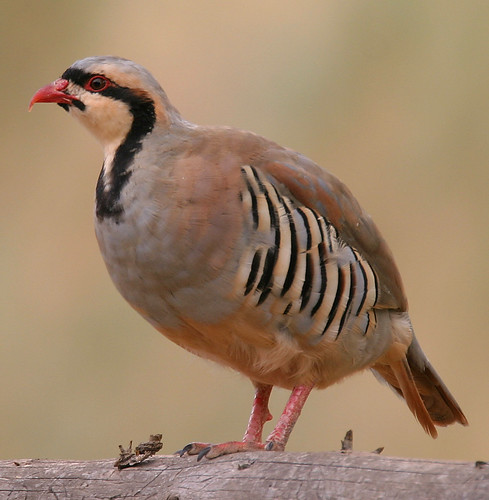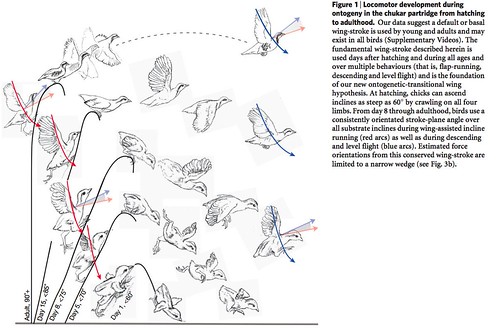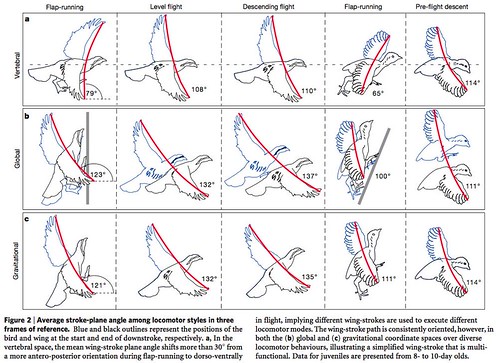tags: researchblogging.org, evolution, avian flight, ornithology, birds, avian, researchblogging
Chukar, Alectoris chukar;
Capitol Reef National Park (Utah, USA) 2004.
Image: Wikipedia [larger view].
For more than 150 years, the evolution of flight in birds has one of the most controversial topics that one can discuss at a professional meeting because this topic splits evolutionary biologists into one of two camps; the "ground up" people who think that birds evolved from dinosaurs that ran along the ground and flapped their wings, either to collect food or to escape predators, and the "trees down" people who think that ancestral birds evolved directly from reptiles that escaped predators by falling out of trees and gliding to safety. But both hypotheses suggest that birds would first need to establish a wide range of wing movement in order to become airborne.
But in 2003, Ken Dial, an experimental functional morphologist (a biologist who studies animal design) surprised the evolutionary world by proposing a third hypothesis for how flight evolved in birds: ancient birds flapped proto-wings to help them run up extremely steep inclines, giving them a survival advantage. Eventually their wings evolved to the point where they became strong enough to allow true flight.
Recently, Dial and another team of scientists, Brandon Jackson and Paolo Segre, all of whom are at the Flight Laboratory at the University of Montana, supported Dial's earlier hypothesis by finding that ancient birds may have learned to flap their wings at the correct angle to fly, regardless of their developmental age, just as their one-day-old hatchlings did.
To do this work, the researchers use high-speed digital cameras that shoot 1,000 frames per second to study the development of flight in Alectoris chukar, a common partridge that lives on the ground, from hatchling chicks, which start out with only small proto-wings, to fully flighted adult birds (figure 1);
[larger view].
As in previous studies by Dial, they filmed the birds going up steep inclines and found that the chukars were actually running rather than flying (figure 1), that the birds used their wings to help their feet stay stuck to the substrate they were climbing, just as a spoiler on a sports car keeps its tires stuck to the track surface.
In this new research, they wanted to learn more about how the chukars moved their wings, and whether the angle of movement changed as the birds matured. Interestingly, after analyzing the film data, the team found that, regardless of whether the birds were traveling up or down a steep incline, the hatchling chicks flapped their wings at the same angle as did the adults, even though hatchlings cannot yet fly (figure 2);
[larger view].
"Birds don't just use their wings when they fly or just their legs to run on the flat; in fact, they recruit both wings and legs for them to scale steep inclines, whether it be a boulder, a tree or a cliff," observed Dial.
Because the hatchling chicks' still developing wings are morphologically similar to the partially formed proto-wings found on some dinosaur fossils, this finding suggests that there is a stereotyped wing-stroke that is essential to avian locomotion and that may help explain evolution of flight in birds. Further, this same wing-stroke is found in other bird species that were also evaluated in the lab using the same methods.
"This is one of those moments when you slap you forehead and say: 'We've been thinking that the wing-stroke is highly specific for different movements but it turns out that Mother Nature just needs a single wing stroke to accommodate all these behaviors," Dial stated.
So in addition to the already mentioned morphological similarities with dinosaur fossils, this behavior is conserved across many extant avian taxa, Dial and his team hypothesize that dinosaurs with a so-called "half a wing" and long cursorial legs might actually have been experiencing an immediate survival benefit by using their proto-wings in the same way that their chukars are doing now.
"That simple wing stroke seems to be elementary to bird evolution and bird ecology to get through the fledgling stage," said Dial.
These data were recently published in the top-tier peer-reviewed journal, Nature.
Sources
Dial, K.P., Jackson, B.E., Segre, P. (2008). A fundamental avian wing-stroke provides a new perspective on the evolution of flight. Nature | doi:10.1038/nature06517. (data figures).
BBCNews (quotes).




It's a great little paper, but I remain a bit skeptical that the mechanic described by Dial et al. can actually be directly applied to the origin of flight. The problem, essentially, is that all of the birds thus far found to be WAIR-capable (and the chukars in particular) have very well developed upstroke excursions and high upstroke power and velocity. The evidence that this ability goes as far back as the base of modern birds (i.e. Neornithines) is strong, but the evidence that it goes back to the base of Aves is much weaker.
Cheers,
--Mike
Beautiful picture of that creature. So amazing! I'm reminded of all the important organs that are on that head. Think of all the important organs, including the brain, that are in and around the Homo sapiens head. Stop and consider the implications of this. The head of the Alectoris chukar and the Homo sapiens "sticks out" beyond the more substantial part of the body and the vulnerableness of it is shocking. Natural Selection operating over a supposed long period of time would certainly have placed such organs in a more protected area. This disproves evolution and proves that natural selection does not work to make for the survival of the fittest. Perhaps there is no such thing as natural selection.
Just,
wondering.
Neither OTW/WAIR, any arboreal or cursorial theories explain the initial aerodynamic act that benefited survival, and would be promoted by natural selection. My theory does and is available at: protobird(dot)blogspot(dot)com (replace "(dot)" with ".")
Enjoy,
Art
Brilliant. That bird was designed by an idiot. An absolutely incompetent amateur. Since you are the first to make this discovery, you can tell god all about his faults and shortcomings. Hopefully he has a better sense of humor than of bioengineering.
And having done that, then 'just wondering' can explain to God how He screwed up all of these designs.